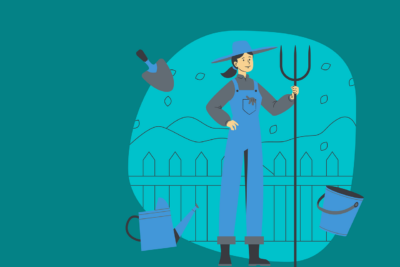Week 10 the last week of our More Farmers More Food Campaign, we looked into the world of bees 🐝
In this Article...
Keeping bees can be a most rewarding experience, good for you and good for the environment.
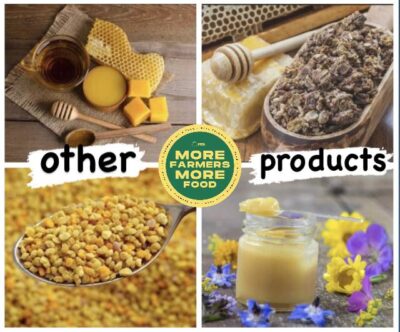
Bee farmers run a business based on the management of stocks of honey bees. These range in scale from small producers, to large scale operations that employ more staff.
To be sustainable, honey bee stocks need to be well managed, healthy and disease free. Good husbandry, as in all livestock farming, is essential.
Income is generated from the sale of honey, beeswax and related products.
The UK produces around 14% of the honey consumed by the domestic market. It’s widely recognised that there is a need to reverse pollinator decline. With good management, it’s in a unique position to help improve crop yields and increase food productivity.
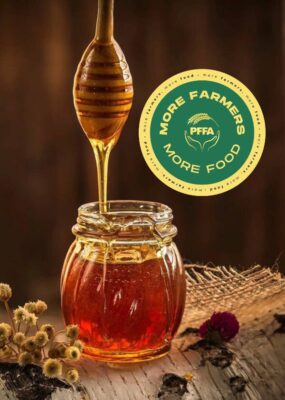
Humans found honey about 8,000 years ago and haven’t stopped using it since.
Honey is not only a delicious natural sweetener but it also has numerous health benefits. It’s rich in antioxidants, vitamins and minerals. It has been used for centuries in traditional medicine for its antibacterial and anti-inflammatory properties. It is also a main component for Ayurveda and traditional Chinese medicine.
Honey controls cholesterol and many studies have proved this. With the help of honey, you can also increase your good cholesterol levels.
Despite being sweet in taste honey doesn’t increase the sugar in the bloodstream and is safe for diabetics but always consult your doctor before changing your diet.
It also treats gastric problems thanks to its anti-microbial and anti-oxidant compounds. It contains methylglyoxal which fights germs and bad bacteria in your digestive tract. It is also great for infections, boosts energy levels, prevents nausea, can reduce sugar cravings (which could help with weight loss) promotes good sleep, helps the respiratory system with conditions such as asthma, can be used to treat dandruff and treats the skin, including acne.
Beeswax is a useful by-product of making honey. It is the foundation of the beehive. Honeybees build the comb from it and fill the cells with honey and brood. Worker bees secrete wax from 8 special glands on the underside of their abdomens. Excluded as a liquid it cools and solidifies. The worker bee shapes it with her legs and makes it into hexagonal cells that make up the honeycomb. Beeswax can be made into a salve or moisturiser and can be used to treat dermatitis, psoriasis and eczema. It moisturises the skin, protects the liver, helps balance cholesterol levels, relieves pain and is anti-inflammatory. It helps to clear acne, treats dry cracked lips and reduces stretch marks. It can also be used to treat fungal skin infections. Beeswax candles are also a relaxant.
Making candles from beeswax cappings is a bit fiddly as a process but it’s not difficult. You can follow videos online. It’s very rewarding when you produce the end result! The candles smell so beautiful and burning beeswax has relaxing properties and it’s much more natural and less toxic than its artificial counterparts sold in the shops that contain artificial colourings and fragrances.
Bee propolis is a mixture of pollen and beeswax. Rich in flavonoids and a class of antioxidants. It has a long history of use as a natural treatment for many health problems.
Bee pollen is a ball or pellet of field-gathered flower pollen packed by worker bees and used as a primary food source for the hive. It is stored in brood cells and it can also be harvested as a food for humans too.
Royal jelly is a powerhouse of a substance that is protein-packed and excreted from the glands of worker bees. In other words, it’s a bee version of mother’s milk. All bee larvae are fed it for the first few days of life but only the ones selected to go on to become queens are bathed in it. Queen bees eat royal jelly throughout their entire lifetime. Humans can consume it too as it’s thought to contain lots of health benefits.
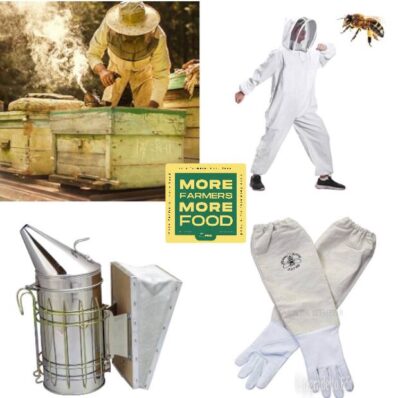
Beekeeping is a rewarding and relaxing pastime, not to mention the delicious honey. You don’t need much space to keep bees, but you do need lots for them to forage on.
As a beginner, it’s best to start with a docile colony, so buy your swarm from an experienced breeder.
In addition to your bees, you’ll need a bee-keeping suit, gloves, smoker and a hive tool if you get the traditional set up. Alternatively, you could get a modern flow hive system instead, which works slightly differently when you collect the honey.
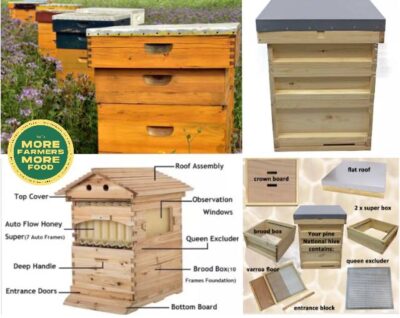
If you would like to keep bees, there are 2 main types of hives. A traditional hive with different layers and functions. Starting at the top you have the outer cover or roof. A crown board helps to ventilate the hive. The supers are the boxes that contain the frames that the bees fill with honey. There is a queen excluder panel that allows the worker bees access but keeps the queen below to lay her eggs separately. The brood box is the living quarters for the bees and the queen’s eggs. The workers store their pollen and honey to feed the young. The bottom board is where the bees fly in and out and the whole thing sits on a stand to raise it above the damp floor.
Or you could use a flow hive with an auto frame. This consists of partly formed honeycomb cells which when they are full you can harvest with a tool that splits them and releases the honey into channels to flow out from a tap at the bottom. Making the honey easier to harvest and less stressful for the bees.
Beekeepers rely on the fact that bees tend to produce more honey than they need. The skill of the beekeeper is to know how much honey to take and still keep the colony happy.
It’s important to check your hive in the spring to make sure the queen is laying eggs and give it a clean. Up until July the colony grows rapidly. You’ll need to check regularly to make sure the hive isn’t full or the bees will swarm and half your colony can leave with the queen. The colony contains a single queen, a few hundred males (drones) and up to 50,000 female worker bees. The queen is much larger and can live up to 3 years. She can lay more than half a million eggs. After hatching she makes a maiden flight and mates with 6 or 7 drones and returns to the hive, where all her needs are met by the worker bees.
Collect the last honey of the year in autumn and make sure they have enough for over the winter. Shut the hive down for the winter and make sure they are safe from unwanted visitors such as woodpeckers and mice.
If you would like to keep bees and produce your own honey, get yourself a good beekeeping book/guide/bible. There are plenty of courses too if you would like to arm yourself with knowledge. But a good book is a great reference source as you go along.
Follow our More Farmers More Food Campaign on Instagram and Facebook.

